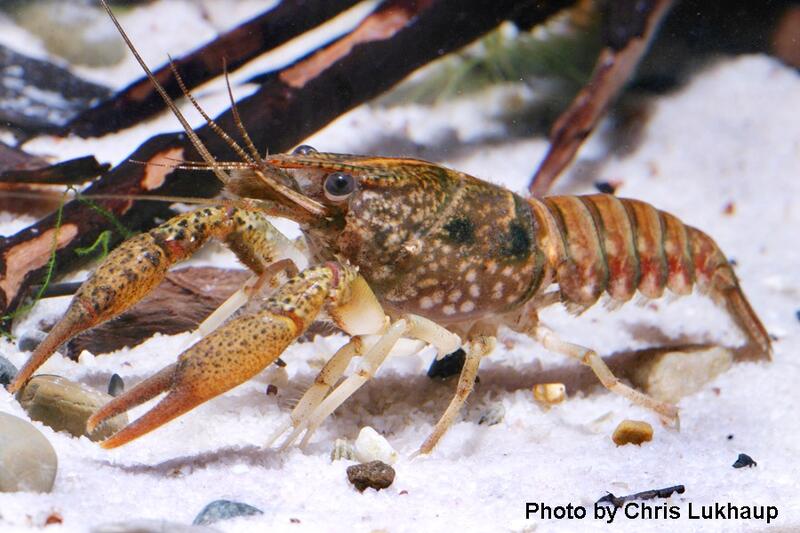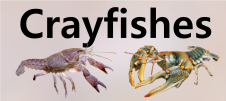







Loading profile. Please wait . . .
Procambarus pubescens (Faxon, 1884)
Brushnose Crayfish




Federal Protection: No US federal protection
State Protection: No Georgia state protection
Global Rank: G4G5
State Rank: S4S5
Element Locations Tracked in Biotics: No
SWAP 2015 Species of Greatest Conservation Need (SGCN): No
SWAP 2025 Species of Greatest Conservation Need (SGCN): No
2025 SGCN Priority Tier: None
Element Occurrences (EOs) in Georgia: 0
Habitat Summary for element in Georgia: Associated with vegetation, woody debris, or undercut banks in permanent streams
The carapace of the Brushnose Crayfish is blackish to brownish with irregular cream splotches. There is a pale stripe down the center of the carapace which is more prominent toward the front. There is a dark saddle across the rear of the carapace which becomes forward pointing “horns” on the upper sides; the horns may be very pale in the middle giving the impression of two spots. The abdomen is reddish-brown and the claws are brown with dark tubercles. The areola is wide and a single cervical spine is present on each side of the carapace. The rostrum is long and tapering and has marginal spines or tubercles. The top of the anterior portion of the rostrum typically has abundant setae which can obscure the acumen (Hobbs 1981). This species reaches a maximum total body length of about 82 mm (3.2 in).
The Brushnose Crayfish is the only species I am aware of that has abundant setae on the top of the anterior portion of the rostrum.
The Brushnose Crayfish is primarily a stream dweller usually associated with some sort of cover, particularly vegetation and undercut banks. It may also be found in leaf litter or associated with rocks or woody debris.
No studies of the Brushnose Crayfish are known. Crayfishes are considered opportunistic omnivores and likely feed on live and decaying vegetation, aquatic insect larvae, small fishes, and dead animal matter.
Stream dwelling crayfishes typically hide during the day and come out at night to feed. Reproduction usually occurs during the spring and fall, but males in reproductive condition may be found at any time during the year. When female crayfish are ready to lay eggs, they usually find a secure hiding place and hence are rarely encountered. When the eggs are released, the female attaches them to her swimmerets and is said to be “in berry.” Upon hatching, the juvenile crayfish are attached to the mother by a thread. After the juveniles molt for the second time, they are free of the mother, but stay close and will hold on to her for some time. Eventually they move off on their own. Crayfishes molt 6 or 7 times during their first year of life and most are probably able to reproduce by the end of that year. Male Brushnose Crayfish in reproductive condition have been collected in every month except January, March, October and November. Hobbs (1981) suggested that breeding males are probably present throughout the year. Twelve females carrying eggs were found in April, June, July, August, and September and three females with young were found in August and September. The smallest breeding male known is about 46 mm (1.8 in) and the smallest female with eggs is about 51 mm (2 in) in length (Hobbs 1981).
Since this species is usually found in flowing water, it is most easily collected by holding a net perpendicular to the current downstream of vegetation or woody debris and kicking to dislodge and scare crayfish into the net. If there are rocks or logs in the creek, they may be carefully lifted and crayfish may be pinned by hand or coaxed into a dipnet. Using a backpack electroshocker or baited minnow traps set overnight can be effective as well.
The Brushnose Crayfish is found from the Oconee River system in Georgia, east to the North Fork Edisto system in South Carolina (Eversole and Jones 2004; Hobbs 1981).
This species is threatened in Georgia by land uses within its range that could alter hydrology and water quality. Introduction of non-native species is a threat to all native crayfishes.
This species is common and widespread in Georgia and is thus considered secure.
General watershed level protection measures will help secure the continued existence of the Brushnose Crayfish in Georgia. These include the protection of riparian zones, control of sediment and nutrient runoff from farms and construction sites, and limiting the amount of impervious cover (e.g., pavement) within occupied watersheds. Non-native crayfishes should never be used for bait. Instead, anglers should use crayfishes collected from the river system they will be fishing in and should never release unused bait crayfish back into Georgia waters.
Eversole, A.G., and D.R. Jones. 2004. Key to the crayfish of South Carolina. Clemson University, Clemson, SC. 43 pp.
Hobbs, H.H., Jr. 1981. The crayfishes of Georgia. Smithsonian Contributions to Zoology 318:1–549.
Taylor, C.A., G.A. Schuster, J.E. Cooper, R.J. DiStefano, A.G. Eversole, P. Hamr, H.H. Hobbs III, H.W. Robison, C.E. Skelton, and R.F. Thoma. 2007. A reassessment of the conservation status of crayfishes of the United States and Canada after 10+ years of increased awareness. Fisheries 32:372–389.
Christopher E. Skelton
C. Skelton, August 2012: original account
C. Skelton, March 2019: general update of account.
D.Weiler, September 2019: photo added